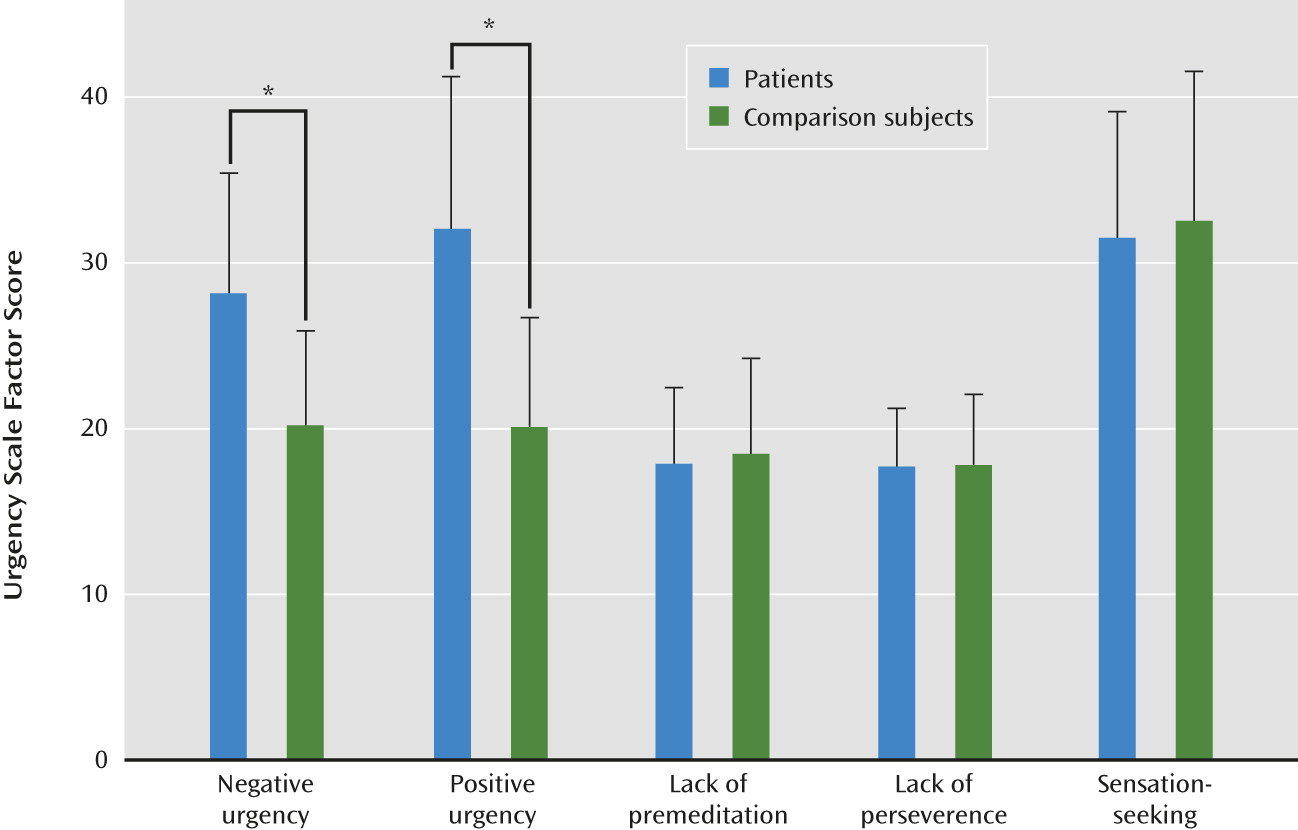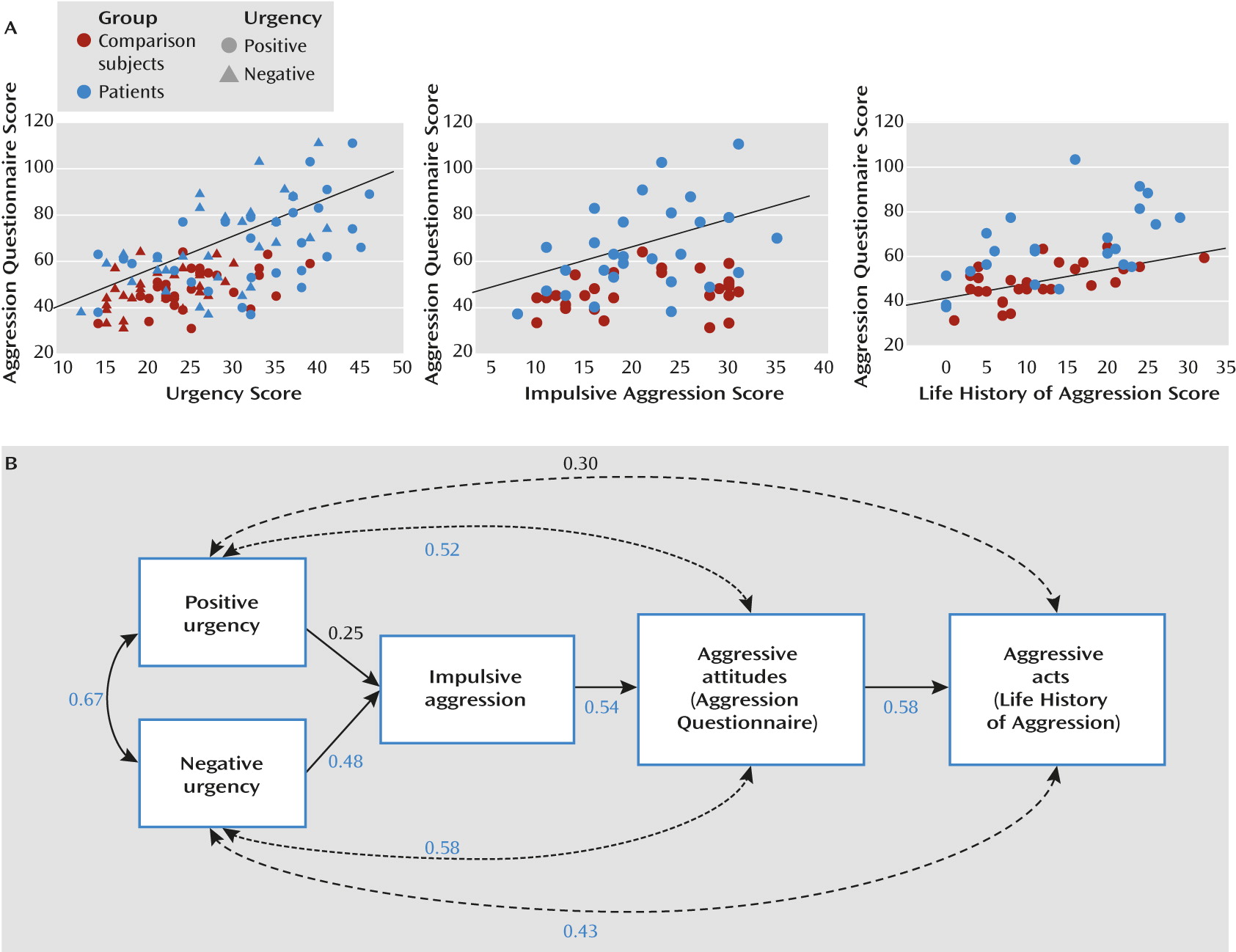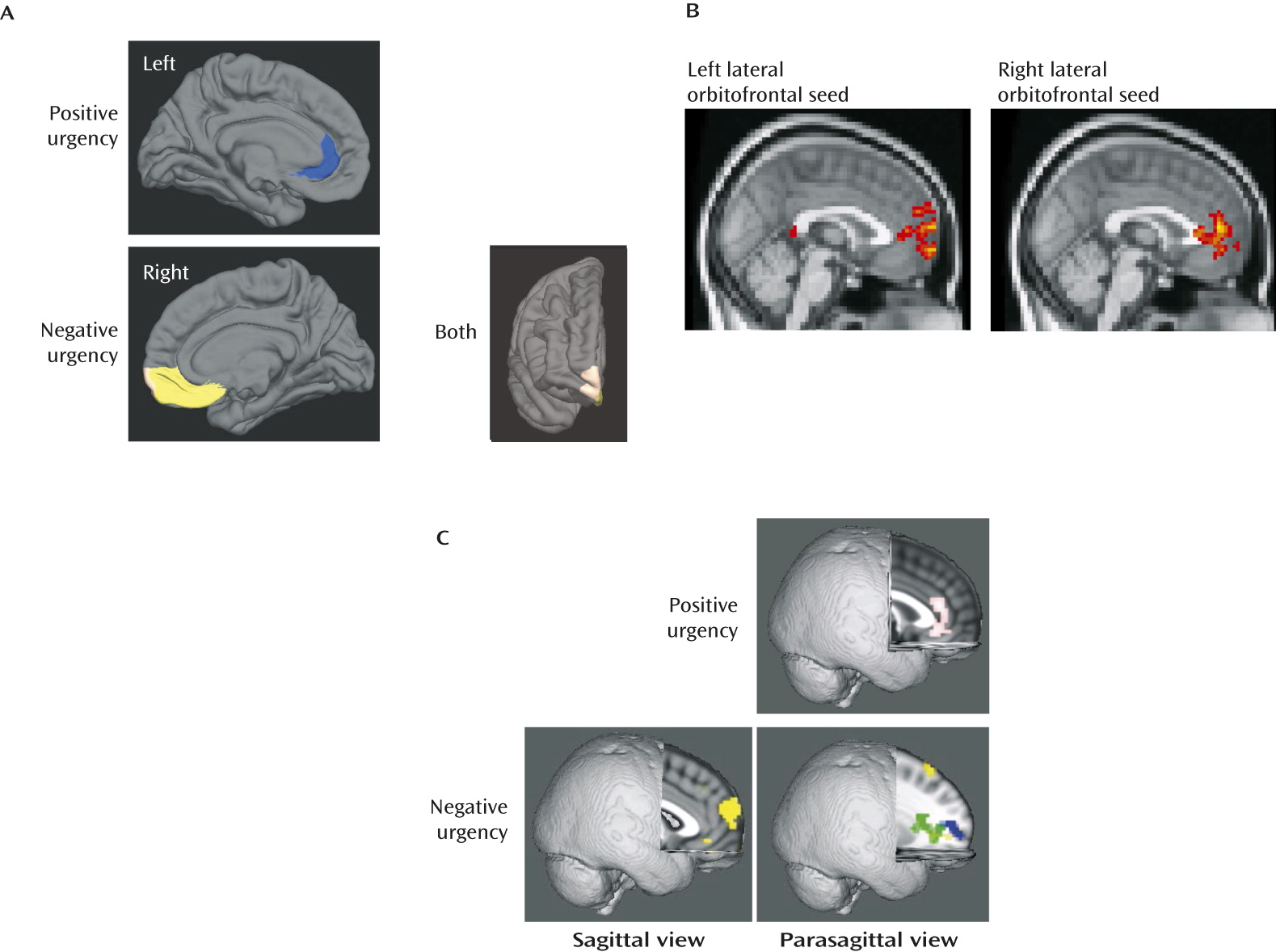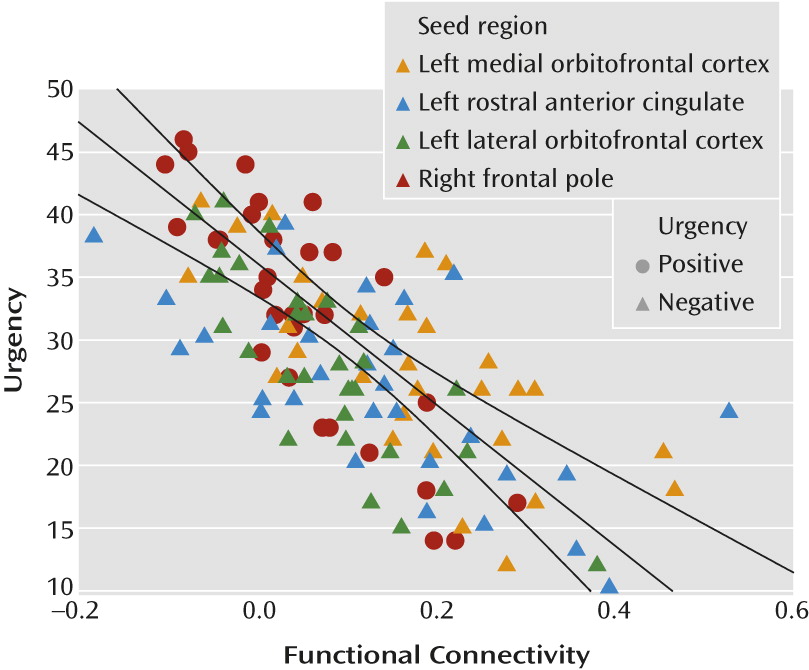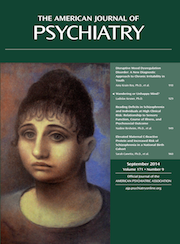Aggression in patients with serious mental illness is a major societal concern. Such aggression can result in serious harm to others, increased stigmatization, institutional admissions, and need for prolonged hospitalizations (
1). Understanding the neural basis for aggression is critical for the development of new prediction, intervention, and treatment approaches. Aggression has societal, intrapsychic, and biological causes; however, a critical contributor, particularly in serious mental illness such as schizophrenia, is impulsivity (
2). It is not clear that this aggression follows the same pathways in serious mental illness as in other populations. Thus, different management plans may need to be developed for these individuals compared with correctional or normative populations.
Impulsivity is a multidimensional construct, but standard measures may not capture important aspects of these phenomena. This problem is addressed by the Urgency, Premeditation, Perseverance, and Sensation-Seeking scale (
3) and its successor (
4), which subdivides impulsivity into the domains that we adopt here. Urgency refers to a tendency to rash action in the context of strong affect, and it is subdivided into positive (for strong positive affect) and negative (for strong negative affect) urgency (
4). Urgency items include, “When I feel bad, I will often do things I later regret in order to make myself feel better now.” The addition of urgency enriches our understanding of impulsivity by incorporating affective dimensions, because some previous models (
5) had conceptualized impulsivity as independent from emotion. Despite extensive literature on impulsivity in schizophrenia, this newer model has not been employed in research on psychotic disorders, although it has been applied to other psychiatric disorders.
In schizophrenia, impulsivity-based aggression may be particularly associated with affective dysregulation. For example, in forensic psychiatric patients (
6) we found that temper, rated by unit nurses, was an accurate predictor of assaultiveness. Similarly, commission errors on go/no-go tasks have been associated with negative urgency (
7).
On a neural level, impulsivity is related to a canonical circuit that involves the right inferior frontal gyrus and presupplementary motor area, subthalamic nucleus, globus pallidus, striatum, and thalamus (
8). Patients with schizophrenia display impulsive responding on behavioral tasks (
9), but where and how this circuit is disrupted in schizophrenia remains a topic of ongoing research. Initially, we observed that aggression in men with schizophrenia correlated with increased white matter diffusivity in right inferior frontal white matter (
10), suggesting reduced local brain integrity (
11). Subsequently, using resting-state functional MRI (fMRI), we observed associations between self-reported aggression and reduced functional connectivity between ventral prefrontal regions and the amygdala (
12), consistent with other literature on neural substrates of aggression in schizophrenia (
13).
Individuals with schizophrenia also display elevations in self-rated impulsivity that correlate with response inhibition-based activation of the ventrolateral prefrontal cortex (
14). By contrast, the results of some functional activation studies (
14) have suggested primary involvement of executive brain regions such as the dorsolateral prefrontal cortex or the dorsal anterior cingulate, leaving critical localizations unresolved.
Urgency, like impulsivity itself, has been putatively localized to regions of the orbitofrontal cortex/ventromedial prefrontal cortex and amygdala and has been linked to reduced GABA levels in the dorsolateral prefrontal cortex (
15). Nevertheless, the basis of the deficit in emotional self-control (i.e., increased urgency) in schizophrenia remains to be determined.
One method that has proven particularly sensitive to regional brain disturbance is MRI-based assessment of cortical thickness (
16). Cortical thickness is reduced in schizophrenia in numerous regions, particularly the orbitofrontal cortex (
17), and is typically thought to reflect primary neurodevelopmental processes that underlie the disorder. These reductions may reflect reduced cell size, reduced cell number, or increased cell density, and they represent an active area of study (
18). Here, we used measures of cortical thickness to both identify pathological regions and to constrain subsequent functional connectivity analyses.
We predicted that urgency would be elevated in patients with schizophrenia and that this would account for substantial variance in aggression, over and above the contributions of group membership, symptoms, or general cognition. On a neural level, consistent with our previous studies, we predicted that increased urgency would correlate with a structural disturbance within ventral prefrontal brain regions and with impaired functional connectivity between these regions and limbic/cognitive control regions.
Method
Participants
The participants were 33 chronic patients who met DSM-IV-TR criteria for schizophrenia or schizoaffective disorder (N=6) using the Structured Clinical Interview for DSM-IV-TR Axis I Disorders—Patient Edition (SCID-I/P) and 31 healthy comparison subjects. Comparison subjects had no major lifetime axis I disorders as determined with the Structured Clinical Interview for DSM-IV Axis I Disorders–Non-Patient Edition (SCID-I/NP) (
Table 1).
Psychiatric symptoms in patients were rated using the Positive and Negative Syndrome Scale (PANSS). These evaluations were missing for eight patients, but participants were drawn from a population similar to our other recent publications (
12). Medication dose was converted to chlorpromazine equivalents (
19). Exclusion criteria were significant head injuries, neurological disorders, and substance abuse diagnoses in the last month or dependence in the last 6 months. Drug abstinence was verified in comparison subjects and outpatients by urine toxicology test; inpatients were presumed abstinent. After we provided a complete study description to the individuals, we obtained written informed consent as approved by the local institutional review board.
Clinical Measures
The urgency subscale of the Urgency, Premeditation, Perseverance, and Sensation-Seeking scale (
4) is described above. Data were unavailable for one patient and one comparison subject because of invalid responses. Group means were imputed for one patient because of missing data after we tested the assumption that these data were missing completely at random using Little’s test (
20). Because we were interested in recent urgency, we told participants to limit their ratings to the last 6 months. Cronbach’s alpha was 0.85 for patients and 0.90 for comparison subjects. For negative urgency, alphas were 0.78 for patients and 0.88 for comparison subjects; for positive urgency, alphas were 0.85 and 0.94, respectively.
The Buss Perry Aggression Questionnaire (
21) measures aggressive attitudes and includes a total score and five subscale scores. The Impulsive and Premeditated Aggression Scale (
22) measures impulsive and premeditated aggression. Per questionnaire instructions, four patients and four comparison subjects who reported no aggressive behavior in the last 6 months were not included in the final sample. The Life History of Aggression (
23) measures aggressive and antisocial acts including assaults, arguments, suicide attempts, arrests, and related behaviors. Interviews were assigned a confidence rating from 1 to 4 for validity with regard to chart content/history. Only participants with confidence scores ≥3 were included in the final sample (23 patients and 27 comparison subjects). The Perceptual Speed Index from the WAIS–III was used as a general cognition measure, and results were available for 25 patients and 30 comparison subjects.
MRI Scanning
Participants were scanned on a 3-T Siemens Tim Trio at the Center for Advanced Brain Imaging at Nathan Kline Institute. A T1-weighted anatomical scan was acquired (TR=2,530 ms, TE=3.5 ms, TI=1,200 ms, matrix=256×256, field of view=256 mm, 192 1-mm slices, no gap), and a 6-minute resting state scan was also collected (TR=2,000 ms, TE=30 ms, matrix=96×96, field of view=240 mm, 34 2.8-mm slices, 0.7-mm gap, acceleration factor=2) with eyes closed.
Image Processing
Cortical thickness.
Anatomical data were processed using Freesurfer, version 5.3 Beta. Cortical thicknesses were extracted for cortical and subcortical regions (
http://surfer.nmr.mgh.harvard.edu/), and data were automatically estimated as the shortest distance from the gray/white boundary to the gray/CSF boundary at each cortical vertex (
16). Data were missing for one comparison subject who had poor scan quality.
Resting-state data.
The resting-state data were preprocessed using Data Processing Assistant for Resting-State fMRI–Advanced (DPARSFA) (
24). Structural images were coregistered to the functional images and then segmented and registered to standard space using statistical parametric mapping nonlinear registration algorithm. Functional images were motion corrected, and nuisance regressors were removed following Yan et al. (
25). The latter included motion parameters and their derivatives, global, white matter, and CSF time series and linear trends. Data were smoothed with a 6-mm Gaussian kernel. Functional connectivity was derived using each participant’s Freesurfer gray matter regions mapped into 3-mm Montreal Neurological Institute space. These included the left and right lateral and medial orbitofrontal cortex, rostral anterior cingulate, and frontal pole. Functional connectivity data were extracted using a custom version of DPARSFA. One comparison subject’s scan was excluded because of image artifacts.
Statistical Analyses
Behavioral data.
Group differences were examined using t tests. We examined differences among Aggression Questionnaire and Urgency Scale subscales using repeated-measures analysis of variance, with group (patient or comparison subject) as the between-subjects factor and subscale as the within-subjects factor. Significant interactions were followed up with t tests, and relationships between variables were examined using correlations. Mediation between variables was examined using multiple linear regression.
Resting-state data.
Analyses were limited to inferior frontal regions in which cortical thickness correlated with urgency scores (see Results section). Functional connectivity was analyzed for each region of interest in regression analyses with group (patient or comparison subject) as the between-subjects factor. In these analyses, mean-centered framewise displacement was used to control for the effects of micromovements (
25). To examine relationships with urgency, these measures were added as covariates, demeaned across groups. One patient and one comparison subject were excluded from analyses because their framewise displacement was two standard deviations above the mean (
25). The groups did not differ on framewise displacement (p>0.24). These procedures produced thresholded z statistic maps of clusters, defined as a z threshold of 2.3 and a corrected cluster threshold of p=0.05 using Gaussian Random Field theory.
Results
Urgency and Aggression
For the Urgency Scale (Figure 1), scores were higher for schizophrenia patients than for comparison subjects (F=14.32, df=1, 60, p<0.001). Only the positive (d=1.50) and negative (d=1.21) urgency subscale scores were differentially higher in patients than comparison subjects, whereas lack of premeditation, lack of perseverance, and sensation-seeking were all unaffected or even somewhat reduced (group × subscale interaction, F=14.86, df=4, 60, p=1.05×10−7). Further analyses therefore focused on both positive and negative urgency subscales. Aggression Questionnaire scores were also higher in patients than in comparison subjects (
Table 1). The group-by-subscale interaction did not reach significance (p=0.28); further analyses were conducted using the total score. Scores were elevated in patients relative to comparison subjects for impulsive aggression (p=0.001) but not premeditated aggression (p=0.16). Life history of aggression scores did not differ between groups.
Correlations Between Aggression and Impulsivity
Elevations in urgency served as strong predictors of aggression in patients (
Figure 2). As expected, schizophrenia patients displayed deficits in general neurocognitive function (
Table 1), but group differences in urgency and aggression remained significant after covariation for perceptual speed index (p values <0.027). Correlations between urgency and aggressive attitudes were also seen in the comparison subjects (see Table S1 in the
data supplement that accompanies the online edition of this article).
However, in mediation analyses (Table 2), urgency measures uniquely accounted for up to 18% of variance in aggression scores (f2=0.34–0.44, a large effect size), over and above the effects of clinical group.Psychopathology and Medication
The Aggression Questionnaire and urgency scores were not significantly correlated with positive symptoms (see Table S1 in the online
data supplement). General symptoms correlated with positive and negative urgency (r values >0.40, p values ≤0.05, N=23). Within general symptoms, negative urgency correlated with anxiety, feelings of guilt, tension, and poor impulse control (r values, 0.41–0.48, p values <0.04, N=23), and positive urgency correlated with anxiety, tension, and depression (r values, 0.41–0.53, p values <0.04, N=23). The magnitude of correlations between measures of aggression and urgency was similar after controlling for general or positive symptoms. Premeditated aggression, but not impulsive aggression, correlated significantly with positive symptoms in general (r=0.45, p=0.031, N=21) and with suspiciousness (r=0.53, p=0.009, N=21), excitement (r=0.60, p=0.002, N=21), and hostility (r=0.42, p=0.047, N=21) item scores. Negative symptoms correlated negatively with the Aggression Questionnaire (r=−0.46, p=0.019, N=27) and the Life History of Aggression (r=−0.52, p=0.019, N=18) scores. Neither urgency, nor aggression, nor imaging measures correlated with medication dosages.
Patients taking clozapine had lower scores on aggressive attitudes (t=2.28, df=31, p=0.031) and on premeditated aggression (t=2.29, df=27, p=0.03) than patients not taking that medication. Behavioral measures did not differ between patients taking mood stabilizers compared with those who were not.
Imaging Correlates
Cortical thickness.
Patients displayed reduced cortical thickness across frontal regions (Wilk’s Lambda, F=2.72, df=18, 44, p=0.003), which were used as variables in subsequent correlation analyses.
In patients, negative urgency correlated inversely with cortical thickness of the right frontal pole (r=−0.64, p<0.001, N=30) and the right medial orbitofrontal cortex (r=−0.36, p=0.042, N=30). Negative correlations were also found in patients between positive urgency and left rostral anterior cingulate thickness (r=−0.38, p=0.031, N=30) and right frontal pole thickness (r=−0.44, p=0.013, N=30;
Figure 3A). Urgency correlations were not significant in comparison subjects.
Functional connectivity.
Group differences and correlational data are shown in Tables S2 and S3 in the online
data supplement. Representative group difference data (comparison subjects > patients) are depicted in
Figure 3B.
For schizophrenia patients, increased positive urgency was associated with reduced functional connectivity between the right frontal pole and rostral anterior cingulate. Negative urgency was associated with reduced functional connectivity a) between the left lateral orbitofrontal gyrus and left middle frontal gyrus, b) between the left medial orbitofrontal gyrus and left superior frontal gyrus as well as the right rostral anterior cingulate, and c) between the left rostral anterior cingulate and left superior/medial frontal gyrus (Figure 3C). Across all regions, correlations were highly significant (
Figure 4).
In contrast, increased positive urgency in patients was associated with increased functional connectivity between the left frontal pole and right middle occipital gyrus. Increases in negative urgency in patients were associated with greater functional connectivity a) between the left lateral orbitofrontal cortex with right inferior/middle frontal gyrus and left cingulate gyrus, b) between the left medial orbitofrontal gyrus with precuneus, c) between the left frontal pole with right superior parietal lobule, and d) between the right medial orbitofrontal gyrus with right cuneus.
In many cases, these positive and negative relationships were themselves inversely correlated. Thus, for example, networks 1 and 5 (from Table S3 in the online
data supplement) were significantly and negatively correlated in schizophrenia patients (r=−0.42, p=0.017, N=29). Similarly, networks 2 and 6 were negatively correlated in patients (r=−0.81, p<0.001, N=29). These results are consistent with the idea that different networks might play a competitive role in the control of variability in behavior (
26).
Discussion
Aggression is an important issue in serious mental illness and may be related to an underlying increase in impulsivity. The present study investigates underlying constructs using the newly developed Urgency Scale, which divides impulsivity into five domains. Increased scores were observed only on the urgency subscales (
Figure 1), which correlated in turn with increased impulsive aggression and tendency toward aggressive acts (
Figure 2). Moreover, urgency uniquely accounted for significant variance in aggression over and above group membership. Increased urgency also correlated with reduced cortical thickness in ventral prefrontal regions and reduced connectivity both within these regions and with cognitive control regions such as the rostral anterior cingulate in patients (
Figure 3). Overall, these findings expand understanding of the pathophysiological basis of increased impulsivity and aggression in schizophrenia and also suggest new approaches for potential therapeutic intervention.
Impulsivity and Urgency in Schizophrenia
Aggression is often considered an intrinsic feature of disorders such as schizophrenia, potentially related to psychosis and premeditation. However, as shown both in this study and elsewhere, to the extent that aggression is increased in stabilized schizophrenia, it is primarily related to increased impulsivity, rather than psychosis, and is not related to premeditation.
Thus, in the present study, elevations in impulsive aggression and aggressive attitudes were observed in schizophrenia patients. In both cases, these scores correlated with increased urgency, but not with symptoms. A weak correlation was observed between both positive and negative urgency and general symptoms, specifically anxiety, tension, feelings of guilt, poor impulse control, and depression.
In contrast to urgency, patients did not show either increased tendency to act without premeditation, as measured by the Urgency Scale (lack of) premeditation subscale, or increased tendency toward premeditated aggression. To the extent that premeditated aggression was observed in our sample, it was associated with increased suspiciousness and positive symptoms. Although recent studies suggest that even when psychosis is more clearly related to aggression, the relationship might be partly mediated by affective impulsivity or dysregulation (
27), the present results may suggest that affective and premeditated aggression represent differentiable subfactors, with psychosis related to premeditated, but not impulsive, aggression. This issue may be clarified in future investigations.
As opposed to schizophrenia, which was associated with selective elevations in urgency scores, other disorders show different profiles. For example, in attention deficit hyperactivity disorder (ADHD), lack of perseverance, lack of premeditation, and negative urgency were elevated when compared with typically developing comparison subjects, whereas sensation-seeking was not (
28). In contrast, negative urgency accounted for differences between ADHD with comorbid oppositional defiant disorder when compared with combined-type ADHD, and both lack of premeditation and lack of perseverance scores discriminated between combined and inattention ADHD subtypes. Negative urgency also correlates with abnormal eating disorders and is significantly correlated with bulimic symptoms even after controlling for the other subfactors (
29). In healthy individuals, positive and negative urgency, as well as anger-modulated response inhibition, have been associated with aggressive attitudes (
30). The determination of neural substrates of urgency, therefore, may be relevant across the dimension of psychotic disorders.
Neural Correlates of Urgency and Aggression in Schizophrenia
Davidson et al. (
31) posited that dysfunction in neural systems controlling affective regulation, including the anterior cingulate cortex, orbitofrontal cortex, and amygdala, might predispose to aggression. Our initial studies in schizophrenia (
10,
12) and the present results are consistent with this model.
Structural correlates.
We found that urgency specifically correlated with reduced cortical thickness of ventral prefrontal regions including the frontal pole, medial orbitofrontal cortex, and rostral anterior cingulate. These findings confirm the findings of others (
32) and extend our previous results, which demonstrated correlation of impulsivity, as a construct, with reduced white matter integrity in orbitofrontal regions (
10). Also consistent with this model, aggression was particularly elevated in those with comorbid substance use, a condition associated with abnormalities in ventral prefrontal structures (
33). In contrast to our findings, Narayan et al. (
34) observed reduced cortical thickness in the inferior medial frontal cortex and sensorimotor regions in violent patients with antisocial personality disorder. Patients with schizophrenia showed thinning in sensorimotor regions only. The Narayan et al. sample was relatively small, which may explain the difference between their results and ours.
Functional connectivity.
In patients with schizophrenia, urgency was also correlated with reduced connectivity of the ventral prefrontal and limbic/cognitive control regions, particularly the rostral anterior cingulate, which are known to be associated with response monitoring and cognitive control (
35) as well as within the ventral prefrontal areas. By contrast, increased connectivity was observed with sensory regions such as the middle occipital gyrus. Patterns of functional connectivity, moreover, differed significantly between patients and comparison subjects. The lack of correlations between cortical thickness and urgency in response-monitoring regions such as the dorsal anterior cingulate and dorsolateral prefrontal cortex, despite their inclusion in functional networks associated with lack of emotional control (i.e., increased urgency) in schizophrenia, suggests that widely observed dysfunction of these regions in some impulsivity tasks in schizophrenia may be because of impaired interaction with the ventral prefrontal and rostral anterior cingulate impulsivity regions.
Many of the networks associated positively versus negatively with urgency were themselves significantly negatively correlated, and may represent competing functional networks. Reduced ability to engage both positively and negatively correlated networks, as well as impaired interaction between them, may therefore lead to the observed increases in urgency in schizophrenia. These competing networks may be linked to positive and negative urgency via poor function and structural deficits in ventral prefrontal regions. Furthermore, impaired competition between these networks may be linked to structural impairments in the ventral prefrontal cortex. This represents a potentially important area for future work.
Treatment Implications
Although positive symptoms have been associated with aggression in patients with schizophrenia in some studies (
36), these symptoms may be less important for inpatients receiving therapeutic dosages of medication, and, as in the present study, may only correlate with premeditated aggression. By contrast, negative symptoms may be protective, consistent with other studies (
36). This protective effect in our sample potentially masked the small effect size increase in aggression that is typically seen in epidemiological schizophrenia studies.
A meta-analysis (
2) highlighted the role of poor impulse control, hostility, substance abuse, and treatment nonadherance in people with serious mental illness, most of whom had schizophrenia. The present study suggests that impulsivity occurs largely in the context of affectivity and reflects increased urgency rather than lack of premeditation, lack of perseverance, or sensation-seeking. Thus, urgency, as a construct, may be closer to underlying biology than impulsivity as a whole, and may therefore represent a preferred therapeutic target.
Furthermore, to the extent that dysfunction of the ventral prefrontal cortex and rostral anterior cingulate represents a primary pathological event, pharmacological and other manipulations should target these regions to ameliorate aggressive attitudes. Successful treatments of aggression may be doing just that. Serotonin transporter binding is reduced in the ventral prefrontal cortex in suicide victims (
37), and low serotonergic tone is predictive of impulsive aggression in a number of patient populations. Clozapine, which has both dopaminergic and serotonergic actions, is a particularly effective antiaggressive agent compared with other antipsychotic agents (
38). Consistent with this notion, clozapine patients had lower aggressive attitudes and premeditated aggression than patients on other medication regimens. It would be interesting to more extensively examine clozapine’s effects on the relationship between urgency and aggression.
In addition to medication-based interventions, stimulation-based treatments such as deep brain stimulation, transcranial direct current stimulation, or transcranial magnetic stimulation are increasingly being employed. For example, anodal transcranial direct current stimulation over the right inferior frontal gyrus improves response inhibition performance in healthy individuals, with progressive improvement over successive treatments (
39). The present study found that elevated urgency scores in patients correlate with reduced functional connectivity of ventral prefrontal regions with the right insula and right rostral anterior cingulate. This finding suggests possible targets for stimulation-based intervention.
Limitations
Several limitations should be kept in mind. First, the measures were self-reported. However, we previously reported that scores on the Aggression Questionnaire correlate significantly with criminal arrest histories (
10,
12), suggesting reliable reporting. Neural localization was also based on structural, rather than functional, measures. Although some neurocognitive tasks exist to examine aggression (
40), tasks examining urgency are in their infancy (
41) but should be incorporated into future studies to complement self-report measures. Moreover, as this is the first study to our knowledge to utilize the Urgency Scale in schizophrenia, issues such as test-retest reliability and its relationship with other impulsivity measures (e.g., Barratt Impulsiveness Scale) need to be assessed. Second, patients were persistently ill and had extensive hospitalization histories, possibly limiting their exposure to situations in which it was possible to conduct aggressive or antisocial acts. These findings need to be replicated in more acute patients with limited exposure to antipsychotics. Moreover, although the present study was not adequately powered to examine the issue of comorbid substance abuse, future studies should focus on this comorbidity. Finally, aggression in schizophrenia is heterogeneous (
42), as is the disorder itself, and this should be considered in future studies.
In our study, we evaluated potential medication effects using dose equivalence measures proposed by Woods (
19). To our knowledge, this is the most widely used method at present for dose scaling across medications (
43), but controversies remain (
44). Studies using the Woods method have demonstrated correlations with specific neurocognitive measures, such as processing speed (
45), suggesting the potential sensitivity of the approach. In this study, we did not find significant correlations between impulsivity and behavior using the Woods approach, but it is possible that correlations would have been observed using different scaling factors.
Conclusions
In summary, although the contributions of dysfunction in the dorsolateral prefrontal cortex to cognitive deficits in schizophrenia are well established, the consequences of gray matter loss within other prefrontal regions have been comparatively less studied. The present study demonstrates a significant and robust association between reduced cortical thickness in ventral prefrontal regions and increased impulsivity in schizophrenia, likely reflecting impaired interaction of these regions with cognitive control regions such as the rostral anterior cingulate. Future studies using tests designed to probe ventral prefrontal function are needed. In addition, we demonstrate that aggressive tendencies in stabilized patients with schizophrenia are tied primarily to increased impulsivity rather than psychosis. Within impulsivity, patients displayed particular elevations in positive and negative urgency, reflecting a tendency to commit impulsive acts primarily in the context of strong positive or negative emotions. A focus on urgency specifically, rather than impulsivity in general, may lead to successful mitigation and prevention of aggression in patients with schizophrenia, which, in turn, would significantly reduce victimization of others, and the suffering of both patients and their families.
Acknowledgments
The authors thank Raj Sangoi (RT)(R)(MR) and Caxia Hu, M.S., for their assistance in scanning study participants; Faith M. Gunning, Ph.D., for her helpful comments on the manuscript; and Chao-Gan Yan, Ph.D., for his assistance in customizing DPARSFA for the resting state fMRI analyses.
